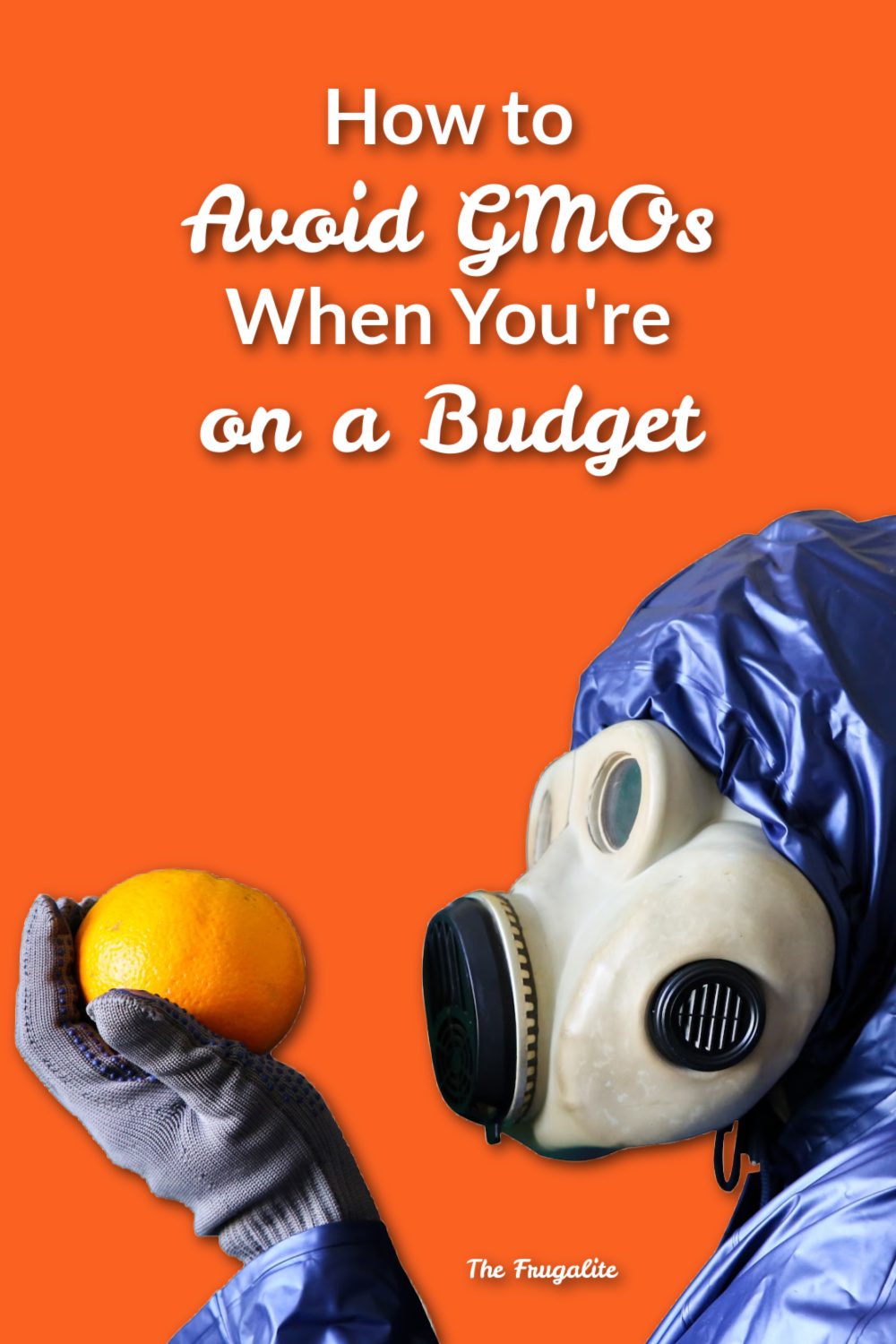(Psst: The FTC wants me to remind you that this website contains affiliate links. That means if you make a purchase from a link you click on, I might receive a small commission. This does not increase the price you’ll pay for that item nor does it decrease the awesomeness of the item. ~ Daisy)
By the author of The Ultimate Guide to Frugal Living and Prepper’s Pantry.
*This article originally appeared as a guest post on Eat Local Grown
What’s the most controversial topic at the grocery store these days? It’s GMOs.
Should you consume them? Are they okay in moderation? Should you strictly avoid them at all times? And if so, how on earth can you manage to navigate the store without stepping into a genetically modified landmine? And if you really want to challenge yourself, how can you do that on a budget?
The anti-GMO movement is picking up steam, for a multitude of excellent reasons. My family is making continuous efforts to remove genetically modified products from our lives. If you want to learn how you can banish them too, read on!
Forget about GMO labeling.
First of all, let’s face some facts here. Crony capitalism in America isn’t going to allow changes that would require the labeling of genetically modified ingredients in your food. While in a perfect world, a place that requires people selling healthfully grown organic foods to jump backwards through hoops and turn a cartwheel to be allowed to place a “certified organic label” on their items, Big Agri can blithely don hazmat suits to spray ever-increasing amounts of glyphosate on crops that have been genetically modified to withstand the poisons, with nary a word to consumers.
The reality is, Monsanto and their ilk have incredibly deep pockets. The Big Food companies that purchase vast amounts of GMO crops are also rolling in money. If you want to avoid GMOs, you can’t look to those who have a vested interest in selling them to protect you. You have to constantly educate yourself to beat them at their own game.
And their game, of course, is Monopoly.
If they refuse to label their products, we can refuse to buy them. Money talks, and to large corporations it SHOUTS. If their bottom line begins to dwindle because people refuse to consume their products, eventually they will have to make a change.
That’s exactly what happened with Dean Foods, actually. In 2009, Dean Foods switched their formula for their popular Silk Soymilk. Instead of using organic soybeans, they began purchasing conventional soybeans. As we all know, nearly all of the soy grown in the United States is genetically modified – at last report it was over 94%. So, more than likely, the soymilk that Dean Foods was putting out was GMO. When outraged customers refused to purchase the product, Dean realized that they were losing money hand over fist, and they switched back to organic soy.
Victory: Team Anti-GMO.
So, you see, that’s how it works. In a free market where consumers have adequate information, their desires direct what is produced. The issue right now is that consumers do NOT have adequate information – at least not without a diligent search for it.
We can wish for labeling until the rBGH-free cows come home, but the battle will have to be fought without the aid of labels.
Avoiding GMOs is easier than you might think. And it can be done on a budget. Here’s how.
Learn to use the labels that DO exist.
Although companies are no required to put warning labels on GMOs, companies can opt to boast when their products are GMO-free.
The Non-GMO Project is focused in the opposite direction of the activists that insist GMOs be labeled. They are working to label products that have been scrupulously tested and are verified NOT to contain genetically modified material.
(Here’s a list of 1,000 non-gmo foods)
The pretty little butterfly label is your best indication that the product in your hand doesn’t contain GMOs. Through a third-party verification process, the products are tested and audited to maintain their standing.
The retailers who started the Non-GMO Project were motivated by a simple idea. They believed that consumers in North America should have access to clearly-labeled non-GMO food and products, now and in the future. That conviction continues to guide the Non-GMO Project, as North America’s only independent verification for products made according to best practices for GMO avoidance.
The verification seal indicates that the product bearing the seal has gone through our verification process. Our verification is an assurance that a product has been produced according to consensus-based best practices for GMO avoidance:
- We require ongoing testing of all at-risk ingredients—any ingredient being grown commercially in GMO form must be tested prior to use in a verified product.
- We use an Action Threshold of 0.9%. This is in alignment with laws in the European Union (where any product containing more than 0.9% GMO must be labeled). Absence of all GMOs is the target for all Non-GMO Project Standard compliant products. Continuous improvement practices toward achieving this goal must be part of the Participant’s quality management systems.
- After the test, we require rigorous traceability and segregation practices to be followed in order to ensure ingredient integrity through to the finished product.
- For low-risk ingredients, we conduct a thorough review of ingredient specification sheets to determine absence of GMO risk.
- Verification is maintained through an annual audit, along with onsite inspections for high-risk products.
Other products sometimes say that they do not contain GMOs. While this may be true, the Non-GMO Project Verified seal is earned through rigorous testing, and you can feel fairly confident that foods bearing this seal are free of genetically modified ingredients.
Another label to look for is USDA Certified Organic.
According to the USDA’s official blog, the inclusion of any type of GMOs is prohibited in an organic product.
The use of genetic engineering or genetically modified organisms (GMOs) is prohibited in organic products. This means an organic farmer can’t plant GMO seeds, an organic cow can’t eat GMO alfalfa or corn, and an organic soup producer can’t us any GMO ingredients. To meet USDA organic regulations, farmers and processors must show they aren’t using GMOs and that they are protecting their products from contact with prohibited substances, such as GMOs, from farm to table.
Sadly, it’s important to note that the USDA has relaxed their standards and “organic” now means 95% or more organic.
Learn about the likely suspects.
In the United States and Canada, two things shout “GMO” like no other: corn and soy. As of 2012, more than 94% of the soy and 88% of the corn in America was genetically modified.
The sad fact is, if you are buying anything processed at all, corn or soy is most likely to be an ingredient. And given the statistics above, it’s almost guaranteed that the corn or soy is GMO unless it’s otherwise noted. Both ingredients masquerade under many names. The lists below may seem overwhelming, but it’s important to see the number of aliases that allow these products to sneak into your food.
Here’s a sobering chart from the website Corn Allergens that shows many of the names under which corn lurks in your food.
- Acetic acid
- Alcohol
- Alpha tocopherol
- Artificial flavorings
- Artificial sweeteners
- Ascorbates
- Ascorbic acid
- Aspartame (Artificial sweetener)
- Astaxanthin
- Baking powder
- Barley malt* (generally OK, but can be contaminated)
- Bleached flour*
- Blended sugar (sugaridextrose)
- Brown sugar* (generally OK if no caramel color)
- Calcium citrate
- Calcium fumarate
- Calcium gluconate
- Calcium lactate
- Calcium magnesium acetate (CMA)
- Calcium stearate
- Calcium stearoyl lactylate
- Caramel and caramel color
- Carbonmethylcellulose sodium
- Cellulose microcrystalline
- Cellulose, methyl
- Cellulose, powdered
- Cetearyl glucoside
- Choline chloride
- Citric acid*
- Citrus cloud emulsion (CCS)
- Coco glycerides (cocoglycerides)
- Confectioner’s sugar
- Corn alcohol, corn gluten
- Corn extract
- Corn flour
- Corn oil, corn oil margarine
- Corn starch
- Corn sweetener, corn sugar
- Corn syrup, corn syrup solids
- Corn, popcorn, cornmeal
- Cornstarch, cornflour
- Crosscarmellose sodium
- Crystalline dextrose
- Crystalline fructose
- Cyclodextrin
- DATUM (a dough conditioner)
- Decyl glucoside
- Decyl polyglucose
- Dextrin
- Dextrose (also found in IV solutions)
- Dextrose anything (such as monohydrate or anhydrous)
- d-Gluconic acid
- Distilled white vinegar
- Drying agent
- Erythorbic acid
- Erythritol
- Ethanol
- Ethocel 20
- Ethyl acetate
- Ethyl alcohol
- Ethyl lactate
- Ethyl maltol
- Ethylcellulose
- Ethylene
- Fibersol-2
- Flavorings*
- Food starch
- Fructose*
- Fruit juice concentrate*
- Fumaric acid
- Germ/germ meal
- Gluconate
- Gluconic acid
- Glucono delta-lactone
- Gluconolactone
- Glucosamine
- Glucose syrup* (also found in IV solutions)
- Glucose*
- Glutamate
- Gluten
- Gluten feed/meal
- Glycerides
- Glycerin*
- Glycerol
- Golden syrup
- Grits
- High fructose corn syrup
- Hominy
- Honey*
- Hydrolyzed corn
- Hydrolyzed corn protein
- Hydrolyzed vegetable protein
- Hydroxypropyl methylcellulose
- Hydroxypropyl methylcellulose pthalate (HPMCP)
- Inositol
- Invert syrup or sugar
- Iodized salt
- Lactate
- Lactic acid*
- Lauryl glucoside
- Lecithin
- Linoleic acid
- Lysine
- Magnesium citrate
- Magnesium fumarate
- Magnesium stearate
- Maize
- Malic acid
- Malonic acid
- Malt syrup from corn
- Malt, malt extract
- Maltitol
- Maltodextrin
- Maltol
- Maltose
- Mannitol
- Methyl glucose
- Methyl glucoside
- Methyl gluceth
- Methylcellulose
- Microcrystaline cellulose
- Modified cellulose gum
- Modified corn starch
- Modified food starch
- Molasses* (corn syrup may be present; know your product)
- Mono- and di- glycerides
- Monosodium glutamate
- MSG
- Natural flavorings*
- Olestra/Olean
- Polenta
- Polydextrose
- Polylactic acid (PLA)
- Polysorbates* (e.g. Polysorbate 80)
- Polyvinyl acetate
- Potassium citrate
- Potassium fumarate
- Potassium gluconate
- Powdered sugar
- Pregelatinized starch
- Propionic acid
- Propylene glycol monostearate*
- Propylene glycol*
- Saccharin
- Salt (iodized salt)
- Semolina (unless from wheat)
- Simethicone
- Sodium carboxymethylcellulose
- Sodium citrate
- Sodium erythorbate
- Sodium fumarate
- Sodium lactate
- Sodium starch glycolate
- Sodium stearoyl fumarate
- Sorbate
- Sorbic acid
- Sorbitan* (anything)
- Sorbitol
- Sorghum* (not all is bad; the syrup and/or grain CAN be mixed with corn)
- Splenda (Artificial sweetener)
- Starch (any kind that’s not specified)
- Stearic acid
- Stearoyls
- Sucralose (Artificial sweetener)
- Sucrose
- Sugar* (not identified as cane or beet)
- Threonine
- Tocopherol (vitamin E)
- Treacle (aka golden syrup)
- Triethyl citrate
- Unmodified starch
- Vanilla, natural flavoring
- Vanilla, pure or extract
- Vanillin
- Vegetable anything that’s not specific*
- Vinegar, distilled white
- Vinyl acetate
- Vitamin C* and Vitamin E*
- Vitamins*
- Xanthan gum
- Xylitol
- Yeast*
- Zea mays
- Zein
Likewise, soy is another item that can be difficult to avoid
Here are some of the names under which soy could be hiding in your food. (List is from About.com)
- Bean curd
- Bean sprouts
- Bulking agent
- Edamame (fresh soybeans)
- Guar gum
- Gum arabic
- Hydrolyzed plant protein (HPP) or hydrolyzed vegetable protein (HVP)
- Hydrolyzed soy protein (HSP)
- Kinako
- Lecithin
- Miso (fermented soybean paste)
- Mixed tocopherols
- Mono- and di-glycerides
- MSG (monosodium glutamate)
- Natto
- Natural flavoring
- Nimame
- Okara
- Shoyu
- Soy (albumin, cheese, fiber, grits, milk, nuts, sprouts, yogurt, ice cream, pasta)
- Soy lecithin
- Soy protein (concentrate, hydrolyzed, isolate)
- Soy sauce
- Soya
- Soybean (curds, granules)
- Soybean oil
- Stabilizer
- Tamari
- Tempeh
- Teriyaki sauce
- Textured vegetable protein (TVP)
- Thickener
- Tofu (dofu, kori-dofu)
- Vegetable gum, starch, shortening, or oil
- Vitamin E
- Yuba
As you can see, it’s difficult to avoid potential GMOs if you eat anything that comes from a package. Despite the fact that many people suffer from food allergies, these items are allowed to be included under names that make it difficult to discern what you’re actually getting. Names like “thickener”, “natural flavoring”, and “drying agent” do not give the label reader much of a clue.
More than 60 GMO crops that have been approved in the US are:
- Corn (20 varieties)
- Oilseed Rape/Canola (11 varieties)
- Cotton (11 varieties)
- Tomato (6 varieties)
- Potato (4 varieties)
- Soybean (3 varieties)
- Sugar Beet (3 varieties)
- Squash (2 varieties)
- Cantaloupe
- Rice
- Flax
- Raddicchio
- Papaya
- Alfalfa
- Wheat
Fortunately, not all of these are currently on the market. Currently corn, soybeans, cotton, canola, squash, and papaya are all sold commercially. (Source: Organic Consumers)
The best possible choices have no label at all.
Bluntly put, food manufacturers are out to deceive the consumer. They know that many people are trying to avoid GMOs, but they still want you to buy their products. This is why they are adamantly against labeling the products, although they like to say it’s because we, the mere mortal customers, just aren’t smart enough or educated enough to comprehend in our fuzzy little brains that GMOs are “safe”. So, they opt not to disclose the inclusion of genetically modified ingredients.
If you shop at the grocery store, then I have to be honest – it’s nearly impossible to avoid GMOs. If every item you purchase is organic, then you can probably get through the checkout line unscathed. But these days, who can afford to push a cart full of organic grocery store food up to the register? I know that I certainly can’t. Prices are sometimes triple that of a conventionally grown item. If you truly want to avoid GMOs – and by avoid I mean banish them from your dinner table and cupboards for good – you need to stop buying food with ingredients. You need to rethink where your food comes from.
Food shouldn’t contain ingredients. Food should BE ingredients. What you purchase when doing your weekly food shopping should be the basis for delicious meals. When you no longer eat things from packages that have long lists of ingredients in them, you will begin to free yourself from the ridiculous Monopoly game that you have been playing with Big Food.
Here are some examples:
- Rather than buying a package of pasta and a jar of Alfredo sauce, make zucchini noodles and a homemade Alfredo primavera.
- Have oatmeal (cooked from scratch – not the little packets) and top it with fruit and nuts, rather than buying a box of flavored, sugar-y cereal for breakfast.
- Instead of a sandwich made from a loaf of processed bread and a deli meat, have a salad made from fresh greens and vegetables, and topped with a slice of chicken that you cooked yourself.
- Don’t open a can of tomato soup, when you can puree some tomatoes and make your own soup instead. Top it with freshly chopped basil.
- Instead of a breakfast sandwich with rubbery eggs on a processed English muffin, make a decadent omelet with farm fresh cheese and vegetables.
None of these meals takes a diploma from Le Cordon Bleu to make. None of these meals started their journey to your table at a factory farm and then on to a facility to be processed into a box on the grocery store shelf, either. They came straight from the garden or farm. Grab some farm-to-table cookbooks or vintage cookbooks
, and you’ll find loads of recipes that are simple, fast, and filling. (My favorites are The Nourished Kitchen
and The Fanny Farmer Cookbook
from 1896.) For more inspiration, think about what you like to eat, and then about how your grandmother would have made it.
It’s time to change your definition of food shopping.
It’s entirely possible for many of us to completely break up with the grocery store. I grow veggies in my backyard and I purchase what I can’t grow from farmers, farmer’s markets, CSAs, and the local co-op. Specific staples like organic sugar and baking items come from online vendors. (I realize that these are the same items I could be purchasing at the grocery store, but I have made the personal choice to no longer do business with that industry. I try to buy direct from farms and small producers as much as possible.)
Don’t limit yourself to produce, either. Be sure to look for meat and dairy products from local vendors as well! The organic free-range chicken that you get from your local farmer is well worth the additional price you’ll pay. If you have a freezer, you can buy many types of meat in bulk (quarter of a cow, anyone?) I’m able to serve free range chicken, rabbit, and grass-fed beef to my family, even on a tight budget, by shopping direct from the farmers. There are few occupations where people work so hard for such a small amount of profit. Farming is a noble profession that doesn’t get the respect it deserves, and I like nothing better than giving my hard-earned dollars to people who give me true nourishment.
But, what am I supposed to eat in the winter?
I can hear some of you saying, “That’s fine in the summer, but what am I supposed to eat in the winter, when there’s nothing local that is being harvested? I’ll have to go back to the grocery store.”
Not necessarily. It’s possible to skip the grocery stores (and the GMOs) even in the winter if you are prepared to do some food preservation when produce is at its peak. If you aren’t familiar with the lost arts, check out some websites, go to a class at your county extension office, or read a book. Canning, dehydrating, root cellaring
, and freezing can make your summer bounty last all through the year. I like to take extra effort when canning fruits and vegetables to make them special, so that we are excited to pop open a jar in the winter. I add vanilla and spices to pears. I toss a little bit of garlic into the jar with green beans. Carrots have a dash of cinnamon and a dollop of honey. Jams are bursting with intense fruity flavor. Relishes, chutneys, and sauces await their invitations to the table, dressing up a wintery dish with a dash of summer. Jars of chewy dehydrated fruits are ready to go into lunchboxes, and dehydrated veggies add a burst of out-of-season nutrition to soups and sauces.
The Whole Buffalo
It’s amazing how far you can make a bushel of peaches extend if you use the “whole buffalo” – a family theory of food economics named by my youngest daughter that means we use every edible part of the item to help stretch our budget. We recently took 100 pounds of peaches (purchased for $1 a pound from an orchard down the road) and made 3 kinds of jam, 3 kinds of canned peaches, peach peel candy, peach liqueur, and peach iced tea. Only then, after getting every last drop of flavor and goodness out of those peaches, pit and all, did we cast the remnants onto the compost pile.
If you think you don’t have time to eschew the grocery store, with its convenient boxes and freezer aisle, reconsider. Fruits and vegetables are the original “fast food”. Many of them can be consumed right after you pick them from the plant.
Challenge yourself to one week without groceries – you may find that the food is so much more delicious and satisfying that you don’t want to go back to the store!
The top 10 things to remember when shopping for non-GMO foods
Don’t buy into the malarkey that it’s impossible to avoid GMOs these days. It’s entirely possible when you stop playing by the rules laid out by Big Food!
Keep these things in mind when purchasing food:
-
Stop looking for labels. Assume that if it isn’t labeled GMO-free, that it contains GMOs.
-
Look for products that are USDA Certified Organic or Non-GMO Project Verified.
-
Avoid all corn, soy, and canola that is not specifically labeled as non-GMO.
-
Familiarize yourself with the abundant aliases for corn and soy.
-
Buy ingredients, instead of food with ingredients.
-
Cook from scratch.
-
Stop shopping at the grocery store.
-
Get to know your farmers personally.
-
Preserve food while it’s in season.
-
Don’t be wasteful. Use every single edible part to make your food dollars go further.
Do you try to avoid GMOs? Do you have other ways of leaving them on the shelf? Please share your thoughts in the comments section.
Resources
GMO Free Diet: How to stay healthy by identifying and avoiding dangerous foods
Genetic Roulette: The Gamble of Our Lives
GMO Food Poison Handbook: ‘Genetically-Modified’ Agriculture and Animals
About Daisy
Daisy Luther is a coffee-swigging, adventure-seeking, globe-trotting blogger. She is the founder and publisher of three websites. 1) The Organic Prepper, which is about current events, preparedness, self-reliance, and the pursuit of liberty; 2) The Frugalite, a website with thrifty tips and solutions to help people get a handle on their personal finances without feeling deprived; and 3) PreppersDailyNews.com, an aggregate site where you can find links to all the most important news for those who wish to be prepared. Her work is widely republished across alternative media and she has appeared in many interviews.
Daisy is the best-selling author of 5 traditionally published books, 12 self-published books, and runs a small digital publishing company with PDF guides, printables, and courses at SelfRelianceand Survival.com You can find her on Facebook, Pinterest, Gab, MeWe, Parler, Instagram, and Twitter.












6 thoughts on “How to Avoid GMOs When You’re on a Budget”
Read labels. Items that ‘may’ be GMO actually ARE required to be labeled. However, it isn’t going to scream GMO. The new verbiage is: This item may contain bioengineered . Avoiding most processed foods is best, but as you mention the non-GMO label is better. Organic can be hit or miss.
Should have been ‘This item may contain bioengineered ingredients’. Sorry about that!
Glad to see you are back and beat the bug.
Welcome back. And to TOG as well.
Nice article 🙂 One corn based item on this list is pretty easy to find in non GMO form, and that’s popcorn. A ton of different kinds of popcron are non GMO, I might even say most, and not just the fancy heirloom varieties. It’s because it’s a totally different kind of corn that is grown for popping and it hasn’t quite been caught up to yet.
If you are lucky enough to live near a Vitamin Cottage/Natural Grocers, they try very hard to keep organic and non GMO foods affordable. It’s still not CHEAP per se but it’s a lot more affordable than some other places I could mention.
Millions think they are “entitled” to have poor quality ingredients labelled as such. Natural in its full meaning should be the base and anything else should carry a warning. In reality, that’s illogical. It is indeed the premium product that pays to have a label. We need more enforcement of food fraud.
One thing you did not mention is freeze drying. Look u Harvest Right and print out their booklet on it. Then order a free sample. Their freeze dryers are around $2000, and will pay for themselves within two years if you use them constantly. Many of your readers should decide they can afford that. Freeze drying preserves more nutrients than any other form of food preservation.
There are cheaper ways of doing the same thing. You can freeze food on the coldest setting of a normal refrigerator and then put it into a vacuum chamber costing $200 or so. This requires more research. Several suitable vacuum chambers can be found on the web. I have not yet managed to try one.
Begin by looking up freeze drying on the web.
Great article!
Glad I’m 95% into my plan B.
We’ve been to the Dominican Republic 4 times over the last couple of years exploring the country in it’s entirety….locating the excellent “old way” farming areas (eastern Cibao valley, home to the world’s largest organic cocoa producing area)…as well as, the industrialized farming areas (the Constanza valley 4,000ft elevation…with BAYER signs plastered all over the place and hunched over farmworkers spraying the crops with who knows what).
As far as I can tell, the area within a 25 mile radius of the city of Salcedo in the Eastern Cibao valley appears ideal for natural food consumers. All I witnessed in this region happened to be super content cows munching away happily in fields, feisty free range chickens and lot’s of old fashioned manure!….NO SHIT… 😉
We are heading back in mid June to finalize the deal….and start looking for a “finca”/farm in the area.
Good luck with whatever you guys do to avoid GMO poisons.